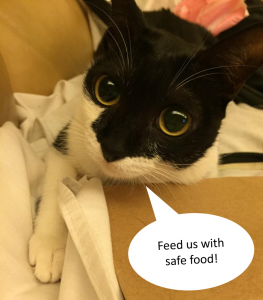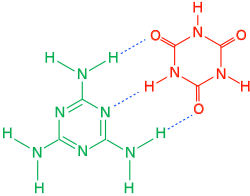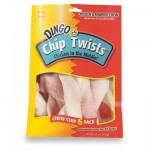(Meat) Pet Food Safety is As Important As Human Food Safety
Surprise! Human is not the only species on earth that consume meat. Cats and dogs we have at home consume meats as well. As raising pets in the family become more and more popular, pet food becomes a high demand in the market. Industrialization comes along and a lot of companies try to lower their price by using many different methods.
One of the method was to lowering the protein content by substituting meat with wheat gluten. Wheat gluten itself does not cause any harm to animals, however, the additional of melamine and cyanuric acid does. Melamine contains 66% nitrogen and it is used for plastic production (Suchy et al., 2009). Cyanuric acid is a bleaching agent and it contains non-protein nitrogen like melamine (Suchy et al., 2009). The combination of melamine and cyanuric acid forms melamine cyanurate and it is an insoluble compound that can block renal function (Suchy et al., 2009). Eventually, it causes renal failure in animals and eventually death (Suchy et al., 2009).
At late 2006 and early 2007, gluten suppliers in China decided to add melamine and cyanuric acid into the wheat gluten to higher the nitrogen value (FDA, 2009). Most protein analyses were based on amount of nitrogen in sample so a higher nitrogen value could trick buyers by claiming a high protein value for their product (FDA, 2009). Buyers would not know that they were buying wheat gluten with non-protein nitrogen chemicals like melamine and cyanuric if the chemicals were not listed out. Pet food companies purchased the wheat gluten and added into their pet food products without knowing the danger of it (FDA, 2009).
In many affected brands, Menu Foods Limited had the highest impact. Menu Foods Limited was a company based in Canada and it sold pet foods across Canada and United State (Smith, 2007). The company “cut and gravy” style pet food was first reported to cause renal failure and death (FDA, 2009). It was also the first company began to recall and had the largest recall in comparison with other companies (Smith, 2007).
Although there were 8500 animal deaths reported to FDA in related to this incident, there were no specific number of affected animals according to FDA (U.S. Food and Drug Administration) because of lack of surveillance network (FDA, 2009; Heavey, 2007).
After the incident, FDA developed a network called Pet Event Tracking Network (PETNet) to improve surveillance (Dangin et al., 2015). The database allows FDA and state agencies to share information about potential outbreaks and pet-food related incidents instantaneously (Dangin et al., 2015). The system was finally finalized at 2011 (Dangin et al., 2015). You might think surveillance would improve after this tragedy, however, nothing has really changed.
In September 2015, a jerky dog treat has reportedly contaminated with amantadine and required to be recall (FDA, 2015a) . Amantadine is an antiviral drug to treat Parkinson’s disease (FDA, 2015b). Certain farms and plants used it to treat avian flu (FDA, 2015b). Although it is allowed to use as a medication for animal in certain countries, it is not approve to be in pet food in the U.S. (FDA, 2015b). This is not the first time that happen in human history. In 2014, there were more than 4800 complaints in regarded of jerky pet treats (Desk, 2014; FDA, 2015b). More than 1000 dogs were reportedly dead because of jerky pet treats from China (Desk, 2014; FDA, 2015b). Although there is no definite correlation with amantadine and the 2014 incident, it is one of the potential cause (Desk, 2014). In term of the source of illness, it is still unknown according to a report given out by FDA in February 2015 (FDA, 2015b). Moreover, complaints in regard of jerky pet treat is still continuing in 2015 (FDA, 2015b).
Dogs and cats cannot choose what they eat. Human have a great responsibility on what they provide to their pets. In 2015, nothing has really improved in term of pet food safety. In the future, we should really make sure that no more poor animals are dead because of our greediness; therefore, we should continue to improve our regulations and surveillance program to protect them.
- View on the incidents
- Do you think people are simply over reacting or should there be more regulation?
- Is globalization good for the food industry or not?
Here is a news report summarizing what happen at 2007:
Here is a news report about jerky pet treat:
Reference:
Dangin, A., Murphy, J., & Melluso, C. (2015, October 5). PETNet: An Information Exchange for Pet Food Related Incidents. Retrieved November 30, 2015, from http://www.fda.gov/AnimalVeterinary/Products/AnimalFoodFeeds/PetFood/ucm278278.htm
Desk, N. (2014, May 20). FDA Update: 1000+ Dog Deaths Potentially Linked to Chinese Jerky Treats. Food Safety News.
FDA. (2009, October 7). Melamine Pet Food Recall – Frequently Asked Questions. Retrieved December 2, 2015, from http://www.fda.gov/AnimalVeterinary/SafetyHealth/RecallsWithdrawals/ucm129932.htm
FDA. (2015a, September 23). Enforcement Report – Week of September 23, 2015. Retrieved December 2, 2015, from http://www.accessdata.fda.gov/scripts/enforcement/enforce_rpt-Product-Tabs.cfm?action=select&recall_number=V-261-2015&w=09232015&lang=eng
FDA. (2015b, February 19). FDA Issues Update on Jerky Pet Treat Investigation. Retrieved December 2, 2015, from http://www.fda.gov/AnimalVeterinary/NewsEvents/CVMUpdates/ucm434865.htm
Heavey, S. (2007, May 4). U.S. petfood recall widens on cross-contamination. Thomson Reuters.
Smith, J. (2007, March 16). Huge pet food recall launched. Toronto Star.
Suchý P, Straková E, Herzig I, Staňa J, Kalusová R, Pospíchalová M. Toxicological risk of melamine and cyanuric acid in food and feed.Interdisciplinary Toxicology. 2009;2(2):55-59. doi:10.2478/v10102-009-0010-6





Winston Liang 7:56 pm on December 1, 2015 Permalink |
I remember a couple years ago, the government is taking my initiatives on ensuring consumers are more aware on whats coming into the country – including proper labeling. Do you think enough is being done? What opinions do you have to the government or consumers to ensure more transparency of what is going into our pets mouths?
Jasmine Lee 11:14 pm on December 1, 2015 Permalink |
It is terrible to hear that a few pet food manufacturers are only concerned about lowering costs and maximizing profits. They are not considering any repercussions that may result from substitution with ingredients of lower value, even if the product is intended for pet consumption. Additionally, this matter may be worrisome for some members of the human community. I have read that a few individuals consume pet food as part of their diet for the purpose of losing weight or to gain nutrition due to the unaffordability of what is generally accepted as “human food”. These vulnerable individuals will be unknowingly exposed to these harmful substances as they are solely relying on the package labels. I agree that there is an urgent need for better regulations and surveillance programs of pet food quality.
elaine chan 1:03 am on December 2, 2015 Permalink |
A nice take on this food blog by talking about animals as victims from consuming food products! I agree with Jasmine’s comment above, it’s certainly disheartening to hear that there are companies out there, that are willing trading their soul for some extra money. The purchasers of this gluten product, and the customers of the pet food products are definitely innocent victims. More specifically, the purchasers ordered this product thinking that it will supply the stated about of nitrogen, so it can meet the consumers’ requirements and produce a nutritious product. And on the customer’s end, they purchased the pet food hoping that it would provide the nutritional value required by their pets. In a situation like this, it’s definitely hard for customers to determine what’s best for their pets because they can only know so much about a product by reading the label. However, on the purchaser’s end, hopefully they can implement more strict raw material testing procedures to help ensure that their final products are safe for consumption by pets.
Jenny T 9:36 am on December 2, 2015 Permalink |
Very informative piece Mandy! This topic on pet food and safety is rarely talked about but is equally important for pet owners to know. This reminded me of the baby formula incident a while back, but pet versoon. Both the pet owners and pets are the victims here because as much as we all want to choose the best product, we place our trust in the FDA and the manufacturers to do their jobs right and ethically. What is worse is that pets won’t be able to tell us what is wrong until it might be too late and they are so reliant on us. I hope the PETNet proves to be effective and FDA does more thorough testing in preventing further incidents like this. Thanks for making us more aware of this issue with this post!
ColleenChong 12:51 pm on December 2, 2015 Permalink |
Thank you for sharing this information. I also remember the incident in china where melamine was added in to baby milk formulas, which caused many health problems to infants. Similar to this incident the compound was added in to the formula to increase the protein content to add value to the product. I agree with Jenny how pet food safety is not considered as important in public. Before reading this blog post I was no aware that this also happens in the pet food industry. I think government regulatory organizations needs to be more proactive in pet food inspection to prevent any alternation of foods that is deemed unsafe to the consumers.
dgozali 6:29 pm on December 2, 2015 Permalink |
Its so sad to hear that pet food safety is not a topic that has been widely discussed or treated as seriously as human food safety. As i have pets myself, I can really identify with this issue as I would try to look up the nutritional content on pet food packages to make sure that the food is healthy for my own pets. I definitely think that it is worth it to create more regulations in order to prevent pet food manufacturers from adding dangerous ingredients. Especially since there are so many pet owners out there and lots of people who support animal welfare causes, they would greatly support the implementation of more regulations to ensure pet/animal safety.
Silvia Low 4:07 pm on December 3, 2015 Permalink |
I had a close encounter with contaminated pet food products before! My sister had purchased a bag of treats for our dog in the past (which he loved) and when he finished it, she asked me to go buy another bag of it. So i went to the store and looked all over for it but couldn’t find it. I asked the sales associate and they said they didn’t sell the brand but that was strange because my sister had bought it from the same store. What i did next is what everyone does… i googled it. And i found out that there was a massive recall on the product just a couple months back because the product was contaminated in the factories they originated from in China. So my dog may have consumed the same contaminated products without us even knowing! But he turned out okay so I’m happy. 🙂
cheryl lau 3:12 pm on December 4, 2015 Permalink |
Great article! As a cat owner, the content of this article is very disconcerting. I agree that it is up to us pet owners to determine if the food is safe for our pets to consume. However, I also think it is important for pet food producers to do their own testing on their raw materials as well. After this incident, I assume that the pet food company has reassessed their procedures on approving suppliers. Although it is quite common in the food industry to choose cheaper raw materials and sacrifice the quality, the consequences can sometimes be very severe, as shown in this article. The protein supplier may have wanted to lower the costs as profit margins are quite low for raw material suppliers, but there are other less harmful ways to do so.
AngeliMalimban 9:28 pm on December 14, 2015 Permalink |
This definitely hits close to home since I have my little dog at home, who just loves to eat everything and anything. I think a lot of companies and people do not realize that what is bad for us is [most likely] bad for dogs, and that there are so many things that we consume that are not good for them either! There definitely should be more regulation for pet food… it really does surprise me that they are only doing something about it now and it was only recently finalized. It sickens me that the companies would add more nitrogen to trick the people into getting more protein… just because it has a higher nitrogen content does not mean the proteins are complete or good for the dog (or even just protein in general). I hope pet owners are smarter than that to believe those tricks. I definitely should check out the ingredients on the label, especially since my dog is becoming old.
DeniseZhang 7:08 pm on December 15, 2015 Permalink |
I was quite surprised by these contaminated pet foods cases. I haven’t heard of any related cases before. I do believe we need to pay the same amount of attention on these pets foods, as we live with our pets and there might be a chance that these contaminated pet foods can affect human beings as well. After reading above comments, as an animal lover, I can’t believe this issue was that close to us. I hope officials can work on improving surveillance on pet foods and even farm animal feeds in the future.
Ya Gao 11:19 pm on December 15, 2015 Permalink |
This is a tragedy to see. I personally have two dogs accompanying me. When I tried to buy treats for them from Amazon, I saw those comments about avoiding dog foods from China at all cost. I didn’t look into specific details until now I know. It is such a pain to see people putting someone else’s pets on danger for money. Because for us, as pet owners, they are part of the family. What I saw in the article above is not just number, I saw heart broken families who lost their beloved family members. This is not one of food borne outbreaks that are sometimes unpredictable. This is an intentional crime!!! The company that added chemicals to pet foods that are known to cause harm on animals should pay for this.
MichelleLui 10:35 pm on December 17, 2015 Permalink |
I agree there are much improvement needed in regulating the pet food. Many pet owners now read the nutrition label for wholesome ingredients or choose reputable brand. Some even cook for their pets. Consumers will have to voice out their concern when it comes to the food safety of pet food. Pet food industry will need to work on controlling the quality and food safety of the ingredients. They need to come from an approved source (e.g. federally registered meat establishment) with certificate of analysis (e.g. heavy metals, pathogens).